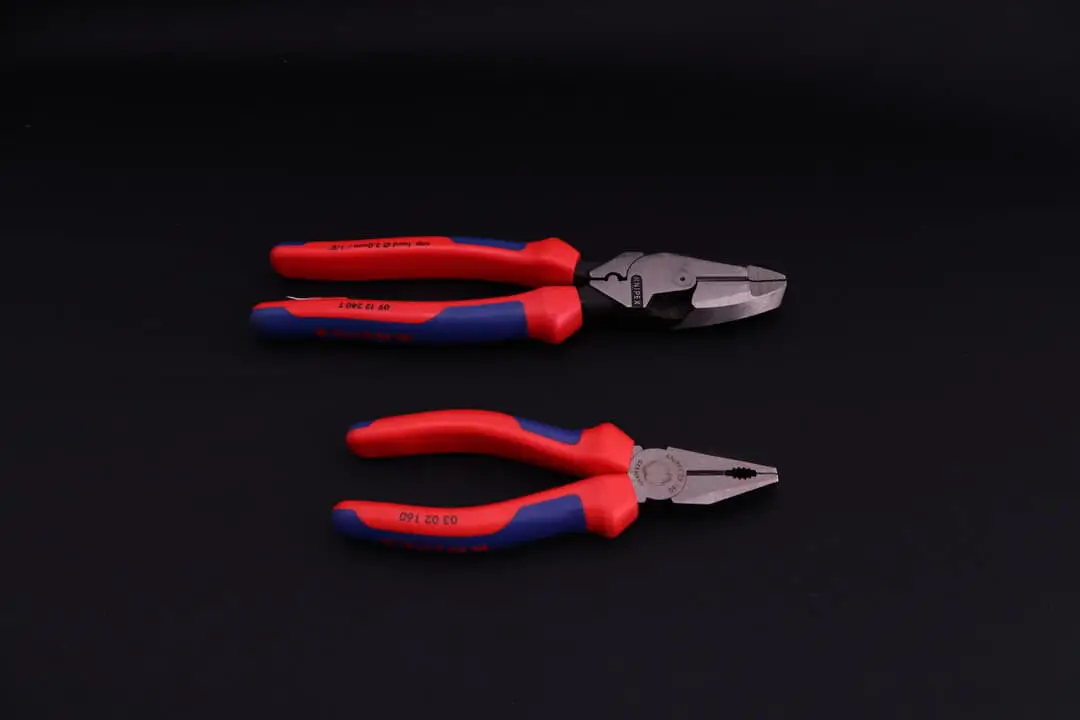Lineman’s and combination pliers are two general-purpose plier types both suited for gripping and cutting. The types are both medium to large in size and with short stubby jaws, they look rather similar, and on a quick glance, you could take them as just the same.
However, Lineman’s and combination pliers are actually not the same, but differ in many important aspects. In this article, I will compare the two pliers types, and show how they are indeed quite different.
In a nutshell, the key differences between Lineman’s and combination pliers are: Combination pliers are smaller (5”…8”), have a separate concave pipe grip for thicker workpieces, and are better suited to general mechanical work; Lineman’s pliers, on the other hand, are larger at 7”…10.5”, have only flat gripping surfaces, but may include special features such as a wire puller and secondary gripping or crimping jaws, and are thus geared towards electrical installation and maintenance.
Below, we will expand on these differences. If you have been wondering how combination and Lineman’s pliers compare, this article should be interesting to you, and which ones are the right choice for your work!
Common features
But first, what do the combination and Lineman’s pliers have in common, and why are they so easy to mix?
- Both are mostly at the larger end of single-hand pliers
- Both are combination pliers: they can both cut and grip
- They have similar jaw shape: short and wide, with height tapering towards the tips.
- The cutting section in the jaws is basically the same in both
- The joint in both pliers is usually very similar
Given the overall similarity, it is easy to confuse combination and Lineman’s pliers for being the same. The differences are, however, significant and noteworthy, and we will next go through them one by one. You can find them outlined also in the table below.
| Combination | Lineman’s | |
|---|---|---|
| Size: | 5”…8” (9”) | 7”…10.5” |
| Gripping jaws: | flat, concave | flat |
| Wire pulling: | none | optional |
| Crimping jaws: | none | optional |
| Secondary gripping jaws: | none | typically yes |
| Popularity: | global | North America |
| Price: | $15…$25 | $20…$60 |
| Applications: | mechanical | electrical, wire |
| Other names: | side cutting pliers (Klein’s) |
Difference 1: Size
A very concrete difference between combination and Lineman’s pliers, albeit one that is not obvious from product photos, is size.
Combination pliers come in a range of lengths between 5’’ and 8’’, and thus vary from medium-sized to large, with 7’’ being probably the most common option.
Lineman’s pliers, by contrast, range from 7” to 10.5” in length, with 9” being the standard length. This means that, on average, Lineman’s are clearly larger than combination pliers, and that even the smallest models are not too small.
The difference between 9’’ and 7’’ may not sound like a big deal, but in practice, it is substantial: typical 9” Lineman’s are more than two times the weight of 7” combination pliers, large enough to be operated by two hands.
Difference 2: Gripping jaws
Combination and Lineman’s pliers differ in the gripping jaw layout.
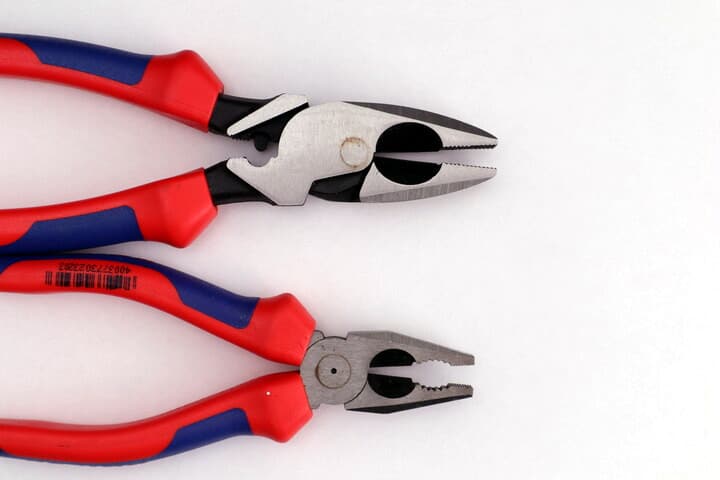
All combination pliers have gripping jaws composed of two sections: a short flat section near the tip, and a concave “pipe grip” section between the flat section and the cutting edges.
The flat section is typically serrated, and allows gripping and pulling flat objects such as steel tape and sheet. The concave section is optimally suited for getting a good grip on thicker round or angular objects, such as wire, rod, small pipes, bolts, and nuts; it is usually features a stronger tooth-like serration, which allows the jaws to bite even into smooth and slippery surfaces.
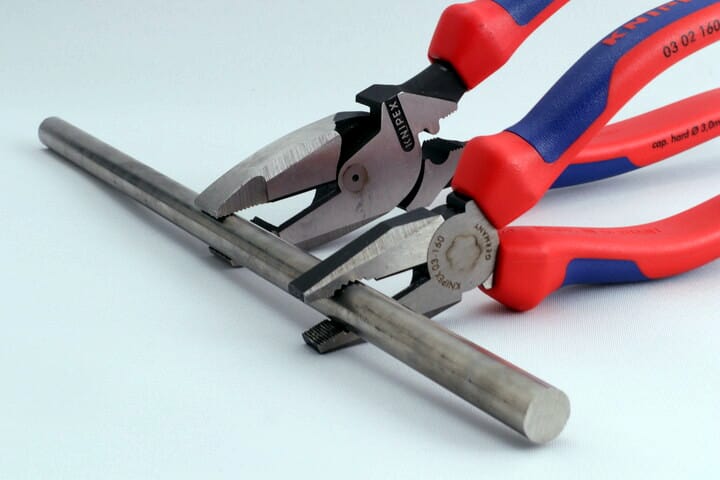
Lineman’s pliers, by contrast, have only a single flat section in their gripping jaws. As space has been saved by not having a concave section, the flat section is larger than in combination pliers. This makes Lineman’s pliers slightly better in handling wire, steel tape and sheet metal; they also allow a firmer grip on soft objects, where the gripping pressure is limited. As the cutting edges start right from the flat section, however, with Lineman’s one must be careful not to accidentally cut what was to be gripped.
Difference 3: Wire pulling
Lineman’s pliers have a special feature not found on any combination pliers: a wire or “Fish tape” puller. This puller is a curved groove below the joint on one half of the pliers, which pinched by the other half when the pliers are closed. The puller allows you to take a very firm and secure grip on wires without damaging the possible coating, and is specifically intended for pulling fish tape in electrical installation work.
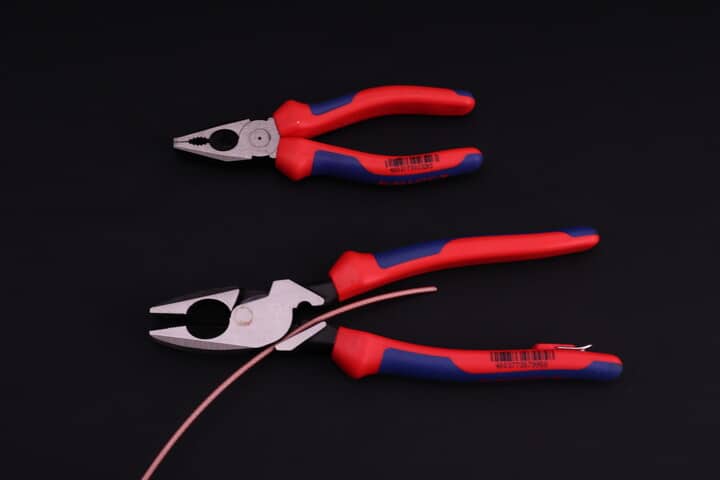
Difference 4: Connector installation
Other special functionality available in some Lineman’s pliers are crimping jaws. These jaws, located below the joint, allow you to install certain types of crimp-fit terminal connectors onto electrical wire.
Although this additional functionality may seem gimmicky and unnecessary in the shop, it may add a lot of value for some professionals working in the field. Added to the already wide functionality of the Lineman’s, it may allow the electrician to dispense with all other pliers in his/her gear and rely on a single pair of pliers for all daily operations, depending on the work flow.
Combination pliers, by contrast, very rarely have any purpose-built feature for installing electrical connectors.
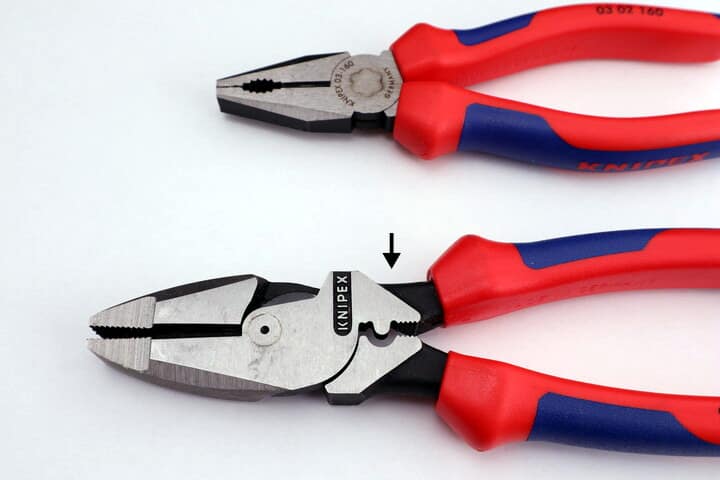
Difference 5: Secondary gripping
Lineman’s pliers often include a further special feature not found in combination pliers: secondary gripping surfaces below the joint (see image above).
These surfaces are usually flat, wide and serrated, and rather similar to the primary ones at the pliers tip. Their placement right below the joint gives them slightly more leverage and allows tighter gripping. These secondary gripping surfaces are excellent for flattening connectors, and can be used also for prying out nails with the pliers tip as the pivot point.
The secondary gripping surfaces are shorter in Lineman’s pliers models which also include crimping jaws below the joint.
Difference 6: Popularity
Combination pliers and Lineman’s pliers have very different regional popularity.
Combination pliers are commonly used around the world, and models are available from probably every pliers manufacturer on the globe.
Lineman’s, by contrast, are distinctly American pliers, and are manufactured and used in much smaller volumes outside North America.
Difference 7: Price
Finally, combination and Lineman’s pliers differ in average price.
Combination pliers are one of the most common pliers types, and, thanks to the high sales volumes, relatively affordable for pliers their size. Standard 7” (or 6½”) models by quality brands may be found under $20, and even larger and special models still below $30.
Reflecting the larger average size and additional features, the Lineman’s are somewhat more expensive than combination pliers. This is particularly true in Europe, where they are a speciality item, and often imported. The most common 9” models often sell at $30 or more, and a rich feature set may increase the price above $50.
Conclusion
As we saw, there are indeed quite a few differences between Lineman’s and combination pliers, despite the similar overall appearance. Let’s conclude the comparison by using the list above to answer the very practical question: which pliers type is better for what?
When combination pliers are better than Lineman’s?
Combination pliers should be preferred to Lineman’s in general mechanical work. Their main comparative advantage are the concave “pipe grips”, which allow the pliers to grab not only flat objects, but thicker ones, such as bolts, nuts, bar, and pipe.
While the greater size and leverage of Lineman’s pliers would often be beneficial in mechanical work, the lack of concave gripping surfaces restricts their overall utility. Moreover, the additional features included in Lineman’s, while useful for electricians and for those working a lot with wire, are not so often needed otherwise.
When Lineman’s are better than combination pliers?
As the name suggests, Lineman’s pliers are preferable to combination pliers for lineworkers and electricians. They benefit from the special features of these pliers, which are tailored for this type of work, and do not often miss the concave gripping jaws.
You may also want to consider Lineman’s pliers if you work mostly with wire and tape: the wider flat gripping surfaces make bending wire easier, and the integrated wire puller may also come in handy. For example, Lineman’s are probably the optimal tool for installing chain link or other wire fencing.
